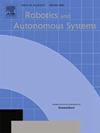POE-based kinematic calibration for serial robots using left-invariant error representation and decomposed iterative method
IF 4.3
2区 计算机科学
Q1 AUTOMATION & CONTROL SYSTEMS
引用次数: 0
Abstract
Most kinematic calibration algorithms overlook the impact of the pose error representation of the robot end-effector on calibration accuracy. In this paper, we demonstrate that the left-invariant error representation (LIEP) provides better pose accuracy than the right-invariant error representation (RIEP) in robot kinematic calibration. Standard product-of-exponentials (POE) kinematic calibration algorithms naturally satisfy the continuity and completeness of the error parameters but lack minimality. We introduce a novel minimal parameterization for the error parameters by analyzing the ineffective error updates during iteration. The number of identifiable parameters is determined as , where and represent the number of revolute and prismatic joints, respectively. In addition, we propose a decomposed iterative method to address the issue of the condition number in the identification Jacobian matrix being affected by the position data, thereby improving the convergence and robustness of algorithm. Finally, we present a POE-based calibration algorithm using the left-invariant error representation and decomposed iterative method, which satisfies completeness, continuity, and minimality. Several factors affecting calibration accuracy in POE-based kinematic calibration algorithms are discussed through simulations and experiments. Both simulations and experiments support our claims, showing that our algorithm outperforms existing methods in terms of orientation and position accuracy.
求助全文
约1分钟内获得全文
求助全文
来源期刊

Robotics and Autonomous Systems
工程技术-机器人学
CiteScore
9.00
自引率
7.00%
发文量
164
审稿时长
4.5 months
期刊介绍:
Robotics and Autonomous Systems will carry articles describing fundamental developments in the field of robotics, with special emphasis on autonomous systems. An important goal of this journal is to extend the state of the art in both symbolic and sensory based robot control and learning in the context of autonomous systems.
Robotics and Autonomous Systems will carry articles on the theoretical, computational and experimental aspects of autonomous systems, or modules of such systems.
 求助内容:
求助内容: 应助结果提醒方式:
应助结果提醒方式:


